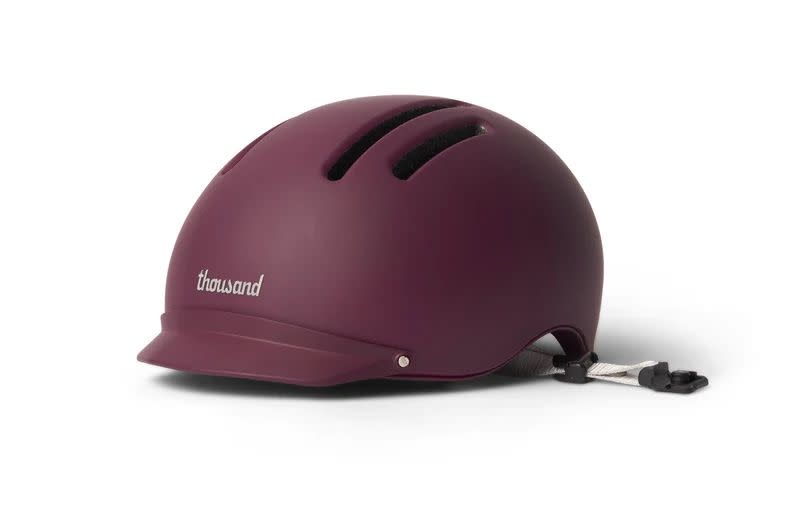Gloria Hwang Has Helped Save 1000 Lives—and She’s Just Getting Started

"Hearst Magazines and Yahoo may earn commission or revenue on some items through these links."
In addition to being one of the few women founders in the cycling industry, Thousand Helmets founder Gloria Hwang is a bit of a former hipster.
Hwang went to college in Austin, Texas’ ground zero for all things punk, alternative, and hip. “At the University of Texas, you could either walk or take the bus to get to your classes and I didn’t want to do either,” she recalls. “A bunch of my friends built up and rode single speed and fixed gear bikes at the time. So I’m like, ‘Okay, cool. I’ll learn how to build a fixed gear bike. I fell in love with the culture and freedom of riding around.”
She still remains a staunch recreational cyclist and commuter today so it makes sense that when she founded Thousand Helmets, she didn’t set out to make a helmet that was more aero, more lightweight, more…cyclist-y. She just wanted a helmet that she and the other casual riders she knew would actually wear.
After a few years of working at Toms, where the primary product is just about the simplest shoe you can imagine, it’s easy to see where the vision for the Thousand helmet design came from. There is serious style in ultimate simplicity.

The company is about more than a commuter-casual aesthetic. “If I’m honest, during college, I never wore a helmet,” she recalls. “I thought they were kind of goofy-looking, and since I didn’t think of myself as a serious cyclist, I didn’t think I needed one.”
That all changed in an instant, though. “A friend of mine passed away from a bad bike accident: he was riding around New York City and wasn’t wearing a helmet,” she explains. “He had a crash where he hit the ground headfirst and he was killed on impact. After that, I knew I needed to start wearing a helmet to be responsible to myself. I went to a store to find something I liked, but couldn’t find one that I really wanted to wear.”
Prominently displayed on the Thousand website is a quote from Hwang reading, “We named our company ‘Thousand’ as a goal of helping to save 1000 lives by making helmets people actually want to wear.”
That’s honorable—and understandable, given her origin story—but how is that a measurable metric?
Rather than just being a pie-in-the-sky statement, Hwang actually means it. Thousand counts every helmet that’s sent in for their lifetime crash replacement program. If you’re wearing a Thousand helmet and you sustain damage to it during a crash, they replace it, no questions asked. Those helmets are the metric Hwang uses to measure how many lives they’ve saved.
Recently, the company celebrated the brand’s 1000th helmet replacement—a major milestone.
Beyond the potential life-saving power of a helmet, Hwang also looked at the social impact helmets could have on bike commuter numbers. We know that most people cite ‘safety’ as a reason they don’t ride, but could some of the safety concerns be mitigated with the right gear?
“I’m a big proponent of making cities more sustainable and reducing CO2 emissions. But when I looked at the data, the big reason people didn’t bike or skateboard or scooter or anything to get around was that they didn’t feel safe,” she says. “We started wondering if getting people to buy into wearing helmets would help increase ridership.”
Thousand is, by Hwang’s definition, a mission- and value-driven brand. They donate one percent of their profits to various charitable organizations, they’ve made commitments to sustainability and lowering or offsetting carbon emissions, and she hopes to continue pushing more inclusivity and diversity in the business, as well as the cycling industry as a whole. (For context, in 2021, Thousand’s employee roster was 40 percent women, 40 percent BIPOC, 25 percent Queer.)
Being a woman in the cycling industry can, on occasion, feel a little lonely and a lot intimidating. That’s changing as more and more women enter the outdoor industry on the whole, but especially in the founder space, it’s still—to be blunt—heavy on the middle-aged white men.
However, rather than this being perceived as a challenge, it can be a positive. And as more and more women enter cycling, the easier it is to “link arms with fellow female founders and women in cycling.”
“Even with companies that you could classify as competitors, when there’s women in leadership, we’re never looking at them from a competitor perspective. It’s always: how do we support each other as women? How do we grow this industry as a whole? Rather than fighting for the current market share, I think we’re getting better at asking how we bring more people—especially women and children—into cycling in the next decade.”
Most people, Hwang points out, aren’t wearing helmets on casual rides right now, and the question shouldn’t be ‘how do I compete with X helmet maker?’ Instead, she says it should be ‘How do we invite people to wear helmets at all? How do we make it an easy choice for them?’
“Why would anyone want to wear a helmet that they think is ugly?” she asks rhetorically. “They’re just not going to. There is a joy you have when you’re riding, and sometimes a helmet can feel it takes the joy component away. So I asked, ‘How do we make sure there is no barrier? How do we remove the disconnect between the joy of riding and safety?’”
Rather than focusing on the typical cycling helmet features we hear about in most gear reviews, Hwang’s design was human-centered, but focused on simplicity and ease of use rather than grams of weight. “Commuters we surveyed wanted style and convenience, not weight or features,” she says.
Since the initial launch of the first helmet, they’ve added components like a magnetic light that attaches to the rear of the helmet but can be pulled off to recharge. There’s a little cap that pops off so you can wind your helmet through a U-lock when you leave your bike outside at the store. The Chapters Commuter Helmet comes stock with MIPS, lest you think that the retro design is an indicator of outdated tech.
And the aesthetic remains classically cool, like something you’d wear to ride a Vespa through the streets of Rome in the 1970s—but available in several colorways.
“My value as a founder has always been just to be able to outwork anyone,” she adds. “My skills are tenacity and a high work ethic. I will always try to outwork my way out of problems, but the last couple of years have taught me that work isn’t always the answer. There are things you can’t change, and I’m learning to take a step back. My role isn’t to try to control an uncontrollable environment, my role is to try to make sure as an organization, we’re best prepared to weather a storm.”
You Might Also Like

